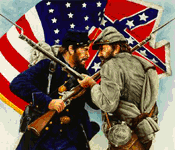 |
Civil War Battles |
|
State War Records |
| AL - AK - AZ - AR - CA - CO - CT - DE - FL - GA - HI - ID - IL - IN - IA - KS - KY - LA - MA - MD - ME - MI - MN - MS - MO - MT - NE - NV - NH - NJ - NM - NY - NC - ND - OH - OK - OR - PA - RI - SC - SD - TN - TX - UT - VT - VA - WA - WV - WI - WY |
The Battle of Fort Bisland
April 12-13, 1863 in St. Mary Parish, Louisiana
 |
|||||||||||||||||||||
|
In April, Maj. Gen. Nathaniel P. Banks launched an expedition up Bayou Teche in western Louisiana aimed at Alexandria. On April 9, 2 divisions crossed Berwick Bay from Brashear City to the west side at Berwick.
On April 12, a 3rd division went up the Atchafalaya River to land in the rear of Franklin intending to intercept a Rebel retreat from Fort Bisland or turn the enemy's position. Maj. Gen. Richard Taylor sent Col. Tom Green's regiment to the front to ascertain the enemy's strength and retard his advance. On the 11th, the Federals began their advance in earnest.
Late on the 12th, Union troops arrived outside the defenses in battle line. An artillery barrage ensued from both sides until dark when the Federals, many of whom were hit by Confederate cannon fire, fell back and camped for the night.
About 9:00 A.M. on April 13, the Union forces again advanced on Fort Bisland. Combat did not begin until after 11:00 A.M. and continued until dusk. In addition to Confederate forces in the earthworks, the gunboat Diana, now in Confederate hands, shelled the Federals. U.S. gunboats joined the fray in late afternoon. The fighting ceased after this. Later that night, Taylor learned that the Union division that went up the Atchafalaya and landed in his rear was now in a position to cut off a Confederate retreat. Taylor began evacuating supplies, men, and weapons, leaving a small force to retard any enemy movement.
On April 14, the Federals found the fort abandoned that morning. Fort Bisland was the only fortification that could have impeded this Union offensive, and it had fallen.
